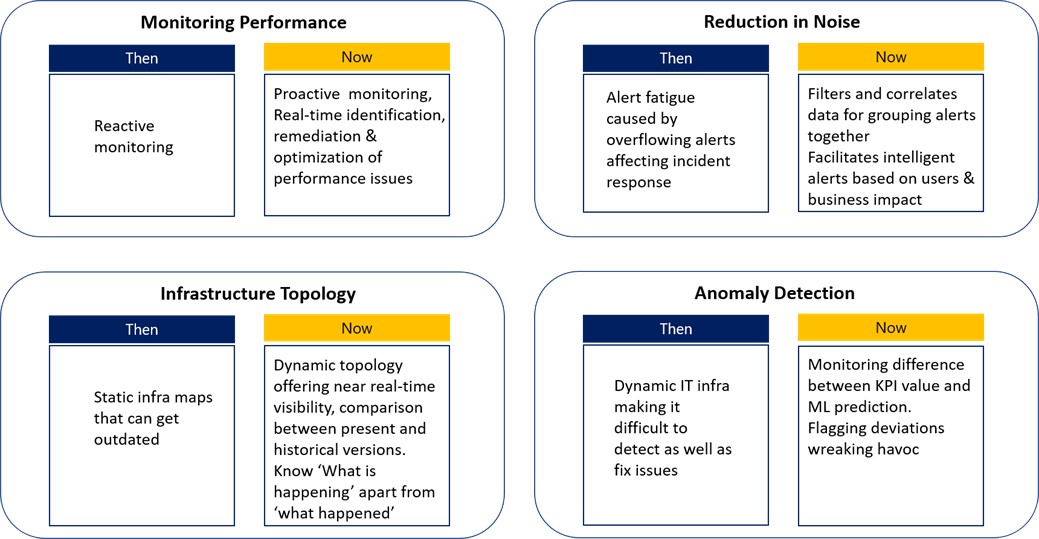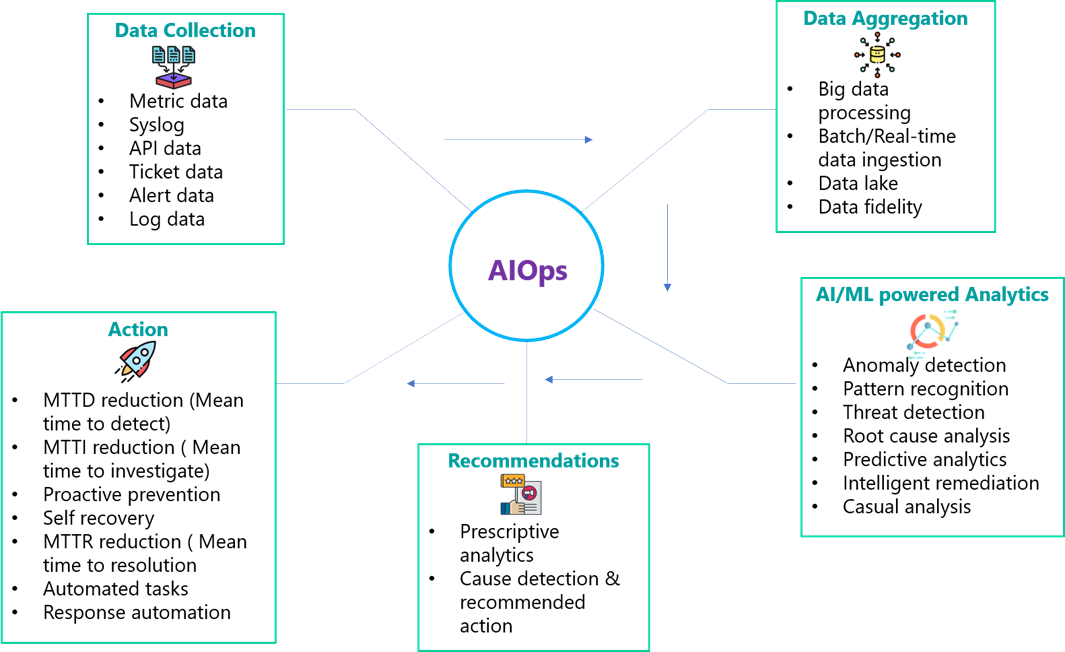AIOps has catapulted into a reckoned tech force in an organization. Sample this scenario bringing AIOps to the limelight.
A Digital Company that had to assure high service quality was facing stumbling blocks. The company was using more than 20 disparate tools to monitor its application estate and infrastructure, but was lacking in skillsets to use their event manager. The ordeal would begin when the L1 operators were overwhelmed with mails, and only 18% of those mails turning into tickets. More than 60% of the tickets turned out to be false positives, and the company was hit hard by outages that happened at least two times in a week.
Enter AIOps that automated real-time analysis and correlation of alert feeds creating a turnaround via 98% reduction in workload and a whopping 487% increase in productivity. And AIOPs, today, is an all-encompassing force empowering enterprise to handle big data and evolving cybersecurity requirements. A robust foundation to address organizational perplexities ranging from the modern application architecture based on Kubernetes, container, mainframe, and microservices, hybrid environments, complexities arising out of multiple cloud adoption to the avowed support for DevOps-powered application deployment cycles. AIOps has become a ‘need-to-have’ force to ensure resilient application performance.
What’s AIOps?
AIOps stands for Artificial intelligence for IT Operations wherein Machine learning, AI, NLP, and other related technologies are applied to traditional IT operations activities and tasks. It helps tame the data avalanche generated by complex IT environments, tap critical insights to facilitate service assurance, accelerate digital transformation and promote enriched user experience.
Now, the IT infra team and IT Ops extract most benefits from AIOps to work faster and smarter. And for IT infra team, AIOps has become an able ally to fulfil the 80-20 rule encompassing problem and resolution. For instance, one of the issues where maximum tickets are raised pertain to the Password change or to the increase in VM space, wherein AIOps infuses automation into these scenarios to reduce the major chunk of tasks for the infra team.
The rise of AIOps is well augmented by a range of AIOps tools and platforms, such as Splunk, AppDynamics, Watson AIOps, LogicMonitor, and PagerDuty, empowering IT ops and infra team to extract insights from increasing volumes of data, embed proactive issue identification, fast track resolution and enhance performance.
AIOps Transformation – A Comparison – Then & Now
To understand how AIOps has transformed IT operations, it pays to make a comparison of IT Operations before AIOps and IT Operations after AIOps has created a transformed operational performance. The figure below illustrates the comparison.

How AIOps Powers this Transformation?
An online retailer was using a traditional solution to handle the data storm brewing from systems and applications. Failing to manage the ever-increasing data only led to system downtimes and customer complaints. Payment processing was one area that was hit hard. Then came AIOps to help the retailer proactively address 34% of a specific problem that led to consistent downtimes, enabled by the predictive capabilities infused by AIOps. The event noise was also brought down by 45- 83%.
The traditional solution had failed to capture signals intelligently, or establish data correlation across environments. And, there were no predictive signals to roll out faster responses to issues and meet customer expectations. Solving critical challenges faced by IT ops, AIOps has eased into the ‘Nice-to-have’ slot. It has eased the pain caused by traditional solutions in terms of leveraging relevant and critical data and extracting signals from the data din, covering three prime aspects.
- Collects and aggregates data from varied sources (multiple sources)
- Enables faster data analysis augmented by big data technology, AI and machine learning
- Automates decisions for talking actions
Data aggregation – Where traditional tools fail to manage the data storm created by the complex IT environment, AIOps solves this issue by capturing data across environments encompassing data of all types and volume while assuring data accuracy for analysis. For instance, data sources could be as varied as agents like chatbots, APIs covering logs and machine data, ETL, real-time applications such as identity tools.
AI, ML & Big data fuelled analytics – AIOPs has also enabled faster data analysis making sure that data is combed intelligently to get signals from the data din. Enabling automated data analysis using AIOPs, a logistics company was able to cut down time taken to identify causes for an issue related performance by about 27% and improve customer engagement.
Diagnosis – Root causes leading to an operational issue is diagnosed paving for quick remediation. AIOps also leads the way to embed automation in specific cases where resolution is enabled without human efforts.
Intelligent automation & AIOPs insights –AIOPs creates an intelligent, single automated platform for faster responses and insights, where Insights are delivered via automation, AIOPs interfaces, display dashboards.
The flow inspired by AIOps, from data din to intelligent automation and actions, is captured in the figure below.

Where AIOps is making a Difference
AIOps has helped enterprises tap into predictive alerting, create warning dashboards to eliminate service disruptions, establish Incident triaging and blueprinting. AIOps is also proving effective in other areas across verticals, and here are some areas where AIOps is making a difference.
- Addressing cybersecurity concerns, AIOps now can pave way for a robust network firewall system as well as AI-powered systems. AIOps is now a reckoned force to promote automated cybersecurity.
- A Telco company has leaned on AIOps to facilitate network reliability. Leveraging cognitive technology, the company was able to pinpoint elements that affected network performance and predict and reduce impact to services. For network performance management, even a delay of milliseconds can ruin user experience. AIOps has fit in well to overcome challenges triggered by complexities of network architecture, ensure seamless user experience.
- Now, AIOps will make a winning combination with DevOps in terms of automating data analysis and DevOps operations, and bolstering DevOps, security, performance, and management.
As we look forward to creating AIOps-driven enterprises, the future promises Robotic Data Automation (RDA) embedded AIOps to enable effective management of complex IT ecosystems.





